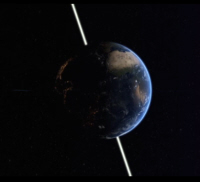Ice Ages
The Periodic Freezing of our Planet

Snowdonia
I travelled back to Britain to uncover the relationship between the Earth's orbit and an ice age. Snowdonia's peaks and valleys were carved out in the last ice age. It's in the mountainous locations like this that an ice age would have begun as snow gradually built up. When we think of ice ages, we think of extreme cold during the winter. But counterintuitively it's summer temperatures which are important in starting ice ages. And the reason for that is, now, ice will build up here during the winter, but it will melt away in the summer. But if the summer as little bit cooler, a layer of ice will be left behind. And a series of cool summers will leave the layer after layer, one on top of the other building up. And here, the ace could have been hundreds of metres high.
Ice ages always start in the northern hemisphere because there is so much more land surface on which ace can build up. So the question is, what causes cooler summers in the northern hemisphere? The answer comes from small changes in the Earth's orbit, caused by the gravitational pull of other planets. Our orbit it isn't exactly the same every time. Aspects of a change just slightly, in cycles lasting thousands of years. And when all of those cycles reach their most extreme point all at the same time, that can change our summer temperatures just enough to tip us into an ice age.

Earth's Angle of Tilt
There are three cycles to do with the Earth's orbit that must all coincide to trigger an ice age. The first of these cyclical changes affects the time of year when perihelion occurs. This is the day when the Earth is closest to the sun. Today, perihelion is in January, but over thousands of years, the date of perihelion changes. When perihelion occurs in the northern hemisphere summer, it makes summers particularly hot. But when it occurs in the winter, as it does today, then northern hemisphere summer's are cooler. So at the moment, the perihelion cycle is at the right point to generate an ice age.
But two other cycles are not in an ice age phase. The first is the angle of the Earth's tilt. The Earth's tilt is currently at an angle to the vertical of 23.4°. But that angle changes between 22° and 24.5°. It's only when angle is at its shallowest, 22° that this season has become less extreme and the summers cooler. Today, the angle of tilt is too great for an ice age.
The final cycle affecting an ice age is the shape of the Earth's orbit. The Earth's orbit is an ellipse but over time, it becomes slightly more, and then slightly less, elliptical. When the orbit is at its most elliptical, the result is lower summer temperatures. At the moment, the Earth is midway through this cycle. So again, it's not in an ice age phase. It's only when all three of these changes to the Earth's cycle lane-up together that they produce the really cool summers in the northern hemisphere that result and ice ages. It will be around 60,000 years before the cycles lineup again in the next ice age starts.
